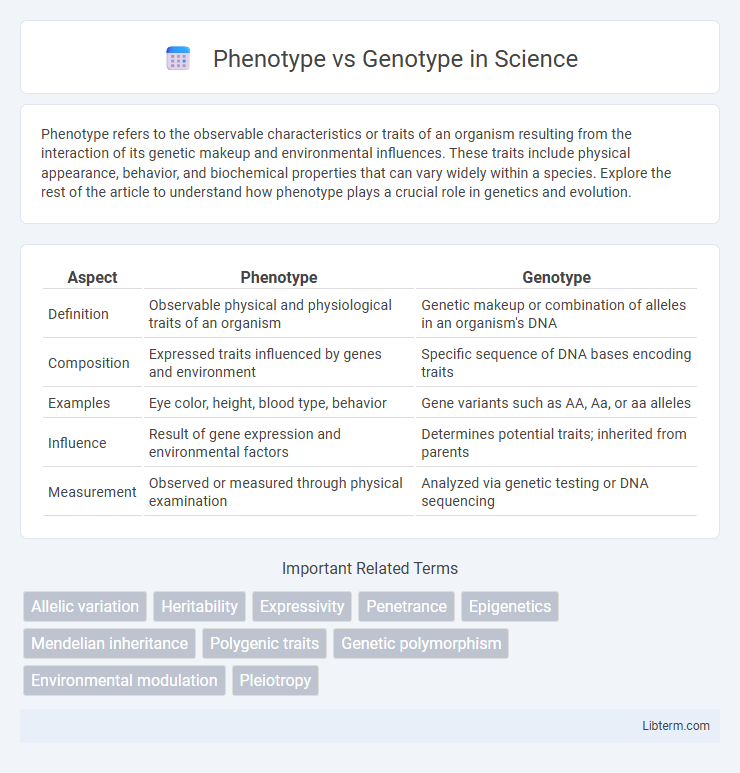Phenotype refers to the observable characteristics or traits of an organism resulting from the interaction of its genetic makeup and environmental influences. These traits include physical appearance, behavior, and biochemical properties that can vary widely within a species. Explore the rest of the article to understand how phenotype plays a crucial role in genetics and evolution.
Table of Comparison
| Aspect | Phenotype | Genotype |
|---|---|---|
| Definition | Observable physical and physiological traits of an organism | Genetic makeup or combination of alleles in an organism's DNA |
| Composition | Expressed traits influenced by genes and environment | Specific sequence of DNA bases encoding traits |
| Examples | Eye color, height, blood type, behavior | Gene variants such as AA, Aa, or aa alleles |
| Influence | Result of gene expression and environmental factors | Determines potential traits; inherited from parents |
| Measurement | Observed or measured through physical examination | Analyzed via genetic testing or DNA sequencing |
Introduction to Phenotype and Genotype
Phenotype refers to the observable physical traits and characteristics of an organism, such as height, eye color, and behavior, which result from the interaction between genotype and environment. Genotype represents the genetic makeup or allele combination inherited from parent organisms, dictating potential traits encoded within DNA sequences. Understanding the distinction between phenotype and genotype is fundamental to genetics, as genotype provides the blueprint while phenotype manifests the expressed traits.
Defining Genotype: The Genetic Blueprint
Genotype refers to the complete set of genes inherited from an organism's parents, serving as the fundamental genetic blueprint that determines potential traits and characteristics. This genetic code, composed of DNA sequences, dictates the synthesis of proteins essential for cellular functions and organismal development. Understanding genotype is crucial for studying hereditary patterns, genetic disorders, and variations influencing phenotype expression.
Understanding Phenotype: Observable Characteristics
Phenotype refers to the observable characteristics of an organism, including physical traits such as height, eye color, and blood type, which result from the interaction of its genotype with the environment. Environmental factors like nutrition, climate, and exposure to toxins can significantly influence the phenotype despite a stable genetic code. Understanding phenotype involves analyzing how genetic instructions manifest into tangible traits, making it essential for fields like genetics, evolutionary biology, and medicine.
How Genotype Influences Phenotype
Genotype represents the genetic makeup encoded in an organism's DNA, serving as the blueprint for various traits. This genetic information directly influences phenotype by determining the potential range of physical characteristics and biochemical processes expressed. Environmental factors can modify phenotypic expression, but the underlying genotype sets the foundational capacity for traits such as eye color, height, and susceptibility to certain diseases.
Environmental Factors Affecting Phenotype
Environmental factors play a crucial role in shaping phenotype by influencing gene expression and the development of observable traits. Variables such as temperature, nutrition, exposure to toxins, and stress levels can alter phenotypic outcomes despite having the same genotype. This interaction between genotype and environment results in phenotypic plasticity, where individuals with identical genetic codes exhibit different traits under varying environmental conditions.
Genotype vs Phenotype: Key Differences
Genotype refers to the genetic makeup of an organism, comprising specific alleles inherited from its parents, while phenotype represents the observable traits resulting from the interaction of the genotype with the environment. Key differences include that genotype is fixed at conception and determines potential traits, whereas phenotype can change throughout an organism's life due to environmental influences. Understanding genotype versus phenotype is essential in genetics, as it explains how inherited information manifests in physical characteristics and behaviors.
Examples Illustrating Phenotype and Genotype
The genotype of a sunflower may carry alleles for yellow or red petals, while its observable phenotype displays the actual petal color, such as bright yellow. In humans, the genotype includes the genetic code for blood type (AA, AO, BB, BO, AB, or OO), but the phenotype reveals the actual blood group, like type A or B. Pea plants demonstrate genotype with combinations like TT or Tt for tallness, yet their phenotype expresses as either tall or short based on dominant or recessive traits.
The Role of Mutation in Genotype and Phenotype
Mutations play a crucial role in shaping the genotype by introducing variations in the DNA sequence that can be inherited across generations. These genetic alterations can lead to changes in the phenotype when they affect gene expression or protein function, influencing physical traits and biological functions. The impact of mutations on phenotype depends on their nature, location, and whether they occur in coding or regulatory regions of the genome.
Importance in Medicine and Genetics Research
Understanding phenotype and genotype is crucial in medicine and genetics research for diagnosing genetic disorders and tailoring personalized treatments. Genotype provides the genetic blueprint, revealing mutations or variations linked to diseases, while phenotype reflects the observable traits influenced by both genetics and environment. Integrating genotype and phenotype data enhances the accuracy of disease prediction, drug response assessment, and the development of targeted therapies.
Conclusion: Implications of Phenotype and Genotype
Phenotype reflects the observable traits influenced by genotype and environmental factors, serving as a practical measure for studying heredity and disease expression. Genotype provides the genetic blueprint underlying these traits, enabling prediction and identification of inherited disorders through DNA analysis. Understanding the interplay between phenotype and genotype enhances personalized medicine, genetic counseling, and advances in biotechnology.
Phenotype Infographic

 libterm.com
libterm.com